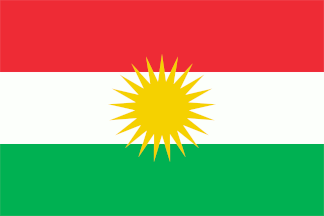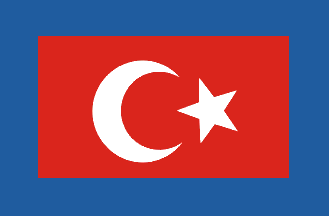 image by Zoltan Horvath, 15 June 2024
image by Zoltan Horvath, 15 June 2024
Last modified: 2025-11-15 by ian macdonald
Keywords: kurdistan | türkiye | iran | iraq |
Links: FOTW homepage |
search |
disclaimer and copyright |
write us |
mirrors
 image by Zoltan Horvath, 15 June 2024
image by Zoltan Horvath, 15 June 2024
The Kurds are the largest national group without a nation state. Since
the First World War, they have enjoyed three brief periods of
geographically-limited near-nationhood, but their own disunity has often
hindered progress. More importantly the existing regional powers have found
Kurdish nationhood threatening, and major powers like the United States have
shared that perspective.
Most of Kurdistan is now divided between Türkiye, Iran and Iraq, and all three countries
have experienced numerous Kurdish insurgencies since 1920. Smaller pockets lie
in Syria, Armenia and Azerbaijan. There are major
communities of refugees throughout western Europe and the United States.
Kurdistan divides into two general socio-linguistic regions at the Greater Zab
River near the Iraqi-Turkish border:
(1) Northern Kurdistan is the Kurmanji-speaking region which mostly
lies in Türkiye (most of eastern Anatolia). Since the 1980s, one of the PKK-related flags has
emerged as the principal flag representing Kurmanji Kurdistan.
(2) Southern Kurdistan is mostly Sorani-speaking and lies principally
in Iraq (north) and Iran (northwest). Also since the 1980s another flag seems to
have emerged as the most widely used for that region.
There is no central authority to legislate flags for Kurdistan, and until
very recently most Kurds did not seem interested in any precision about flags. I
have some friends who were very close to government officials of the former Mahabad Republic, and
they insisted 15 years ago that there was no Kurdish flag. They were surprised
when I presented historical evidence to the contrary.
T. F. Mills, 27 September 1997
Editor's note:: Most of the following information is reproduced from the former website of the Center for Kurdish Political Studies [no longer on-line] with kind permission of its director, Bijan Eliasi.
The aim of this document is to introduce in brief the history of the current National Flag of Kurdistan and to help those who use the Kurdish national flag to reproduce it correctly. The document contains the basic rules for the construction of the flag as well as the standard colors to be used.
The National Flag was first introduced by the leaders of the Khoyboun, ("independence") movement to represent the Kurds in their struggle for independence from the moribund Ottoman Empire. It was subsequently presented to the members of the international delegation at the Paris Peace Conference that devised a plan for Kurdish independence as a part of the Treaty of Sèvres with Ottoman Türkiye in 1920. Under the same flag the Khoyboun announced the formation of the first "Kurdish Government in Exile" in 1927 and fought a drawn-out war until 1932, in order to revive the Kurdish national independence, lost since 1848.
In 1946 and the creation of the Republic of Kurdistan at Mahabad, the old "sunny flag" was adopted by its parliament as the official Flag of the Republic. Following these historic background, the National Flag is widely adopted in Kurdistan and has been set aloft by various Kurdish movements and entities in all sectors of the land.
The "sunny flag" has thus been consecrated by the blood of all Kurdish patriots of this century, from tens of thousands who fell in defending the independence movement under the Khoyboun, to the President of the Republic of Kurdistan and his elected cabinet who were hanged in sight of this flag by the foe. The flag was aloft when Dersim was immolated in 1938; it was aloft when wounded Kurds on stretchers were placed before the firing squads in 1980; it was aloft when Kurdish civilians were gassed in their thousands in cities and towns in 1988; it was aloft when millions were driven from their villages and towns that have been set alight since1989; and, it remains aloft everywhere today--150 years after the loss of Kurdish independence--when Kurds are redoubling their perennial struggle to regain their dignity and equality with other nations by reviving their right to choose the course of their own future.
The Kurdish flag has three horizontal bands. The upper stripe is red, the middle one white and the bottom band green. The width of the flag is two-thirds of the length. The primary Kurdish characteristic of the flag is the golden emblem at the center. The sun emblem has a religious and cultural history among the Kurds, stretching into antiquity. The sun disk of the emblem has 21 rays, equal in size and shape. The number 21 holds a primary importance in the native Yazdani religious tradition of the Kurds.
 image by Ivan Sache, 08 May 2003
image by Ivan Sache, 08 May 2003
The diameter of the sun disk is 0.5 without the rays and 1.0 with the rays (considering the 2x3 dimensions of the flag). The rays are keen-pointed at the end, with their sides made of straight lines. No space separates two adjacent rays at their base which touch on the disk, thus leaving no part of the sun disk exposed. The sun emblem is situated at the geometric center of the flag. The sun is placed in such way the vector going through its uppermost odd ray is perpendicular to the length.
I have just learned that the Kurdish Government have apparently adopted the
flag specification I drew up for them a few years ago – see
http://www.kurdistan-parliament.com/KurdishFlag_english.htm.
The flag is in the following colors, according to Pantone matching system:
Christopher Southworth, 05 September 2006
The Kurdish Institute in Paris maintains a website with illustrations,
specification and also gives color values in Pantone system:
https://www.institutkurde.org/en/kurdorama/the_national_flag_of_kurdistan.php
Other sources for colors:
The Olympic Flag Manuals are not
relevant in case of Kurdistan, because it is not member of IOC, the athletes
compete as member of Iraqi Olympic team, or special group of Individual
Athletes.
The Album des Pavillons 2000 [pay00]
doesnít illustrate the flag of Kurdistan.
Kurdistan is illustrated in the
Album des Pavillons 2016 for the first time, and the yellow color added to color
specifications.
Yellow: Pantone 116c, CMYK 0-16-100-0
The Album des
Pavillons 2023 illustrates the flag, but doesnít give separate the color
specification, only colors of Iraqi flags with yellow added.
Red: Pantone
186c, CMYK 14-100-79-4, RGB 200-16-46
Yellow: Pantone 116c, CMYK 0-21-93-0,
RGB 255-204-0
Green: Pantone 7732c, CMYK 88-26-94-12, RGB 0-123-61
Vexilla Mundi doesnít illustrate flag of Kurdistan.
Wikipedia gives color values as
follows:
Red: RGB 235-35-35, Hex #ED2024
Green: RGB 39-138-65,
Hex #278E43
Yellow: RGB 250-185-20, Hex #FEBD11
White: RGB
255-255-255, Hex #FFFFFF
Flag Color Codes gives the following color values:
Red: Hex. # ED2024, RGB 237-32-36, CMYK 0-87-85-7, Pantone 1788 C, RAL 3026
White: Hex. # FFFFFF, RGB 255-255-255, CMYK 0-0-0-0, Pantone N/A, RAL N/A
Green: Hex. # 278E43, RGB 39-142-67, CMYK 73-0-53-44, Pantone 7731 C, RAL
6032
Yellow: Hex. # FEBD11, RGB 254-189-17, CMYK 0-26-93-0, Pantone 1235
C, RAL 2007
Zoltan Horvath, 15 June 2024
Similarly, there are two entities which claim to officially represent the Kurds:
Ivan Sache, 19 November 1999
 image by Jaume Ollé Casals, 1 July 2012
image by Jaume Ollé Casals, 1 July 2012
I saw the flag of the Kurdish militia that fought together the Turkish army against PKK on the Catalan TV channel TV3 on 21 February 1999, in a report about the conflict in Eastern Türkiye.
Jaume Ollé Casals, 1 July 2012